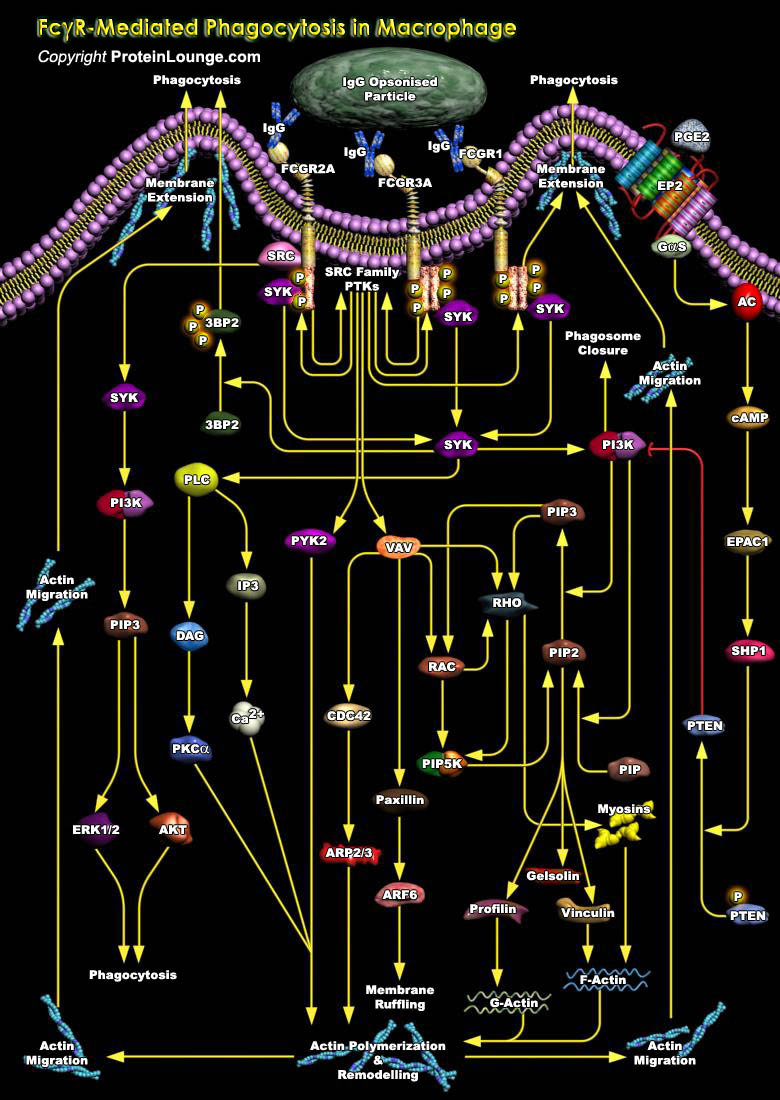
Phagocytosis, defined as the cellular uptake of particulates (>0.5 m) within a plasma-membrane envelope, is closely related to and partly overlaps the endocytosis of soluble ligands by fluid-phase macropinocytic and receptor pathways. The uptake of exogenous particles (heterophagy) has features in common with autophagy, an endogenous process of sequestration and lysosomal disposal of damaged intracellular organelles. There is a spectrum of uptake mechanisms depending on the particle size, multiplicity of receptor-ligand interactions, and involvement of the cytoskeleton. FcRs bind to the constant (Fc portion) of IgG (Immunoglobulin G) or IgA antibodies. IgGs act as opsonins, molecules that render the particle they coat more susceptible to engulfment by the phagocytes.[..]
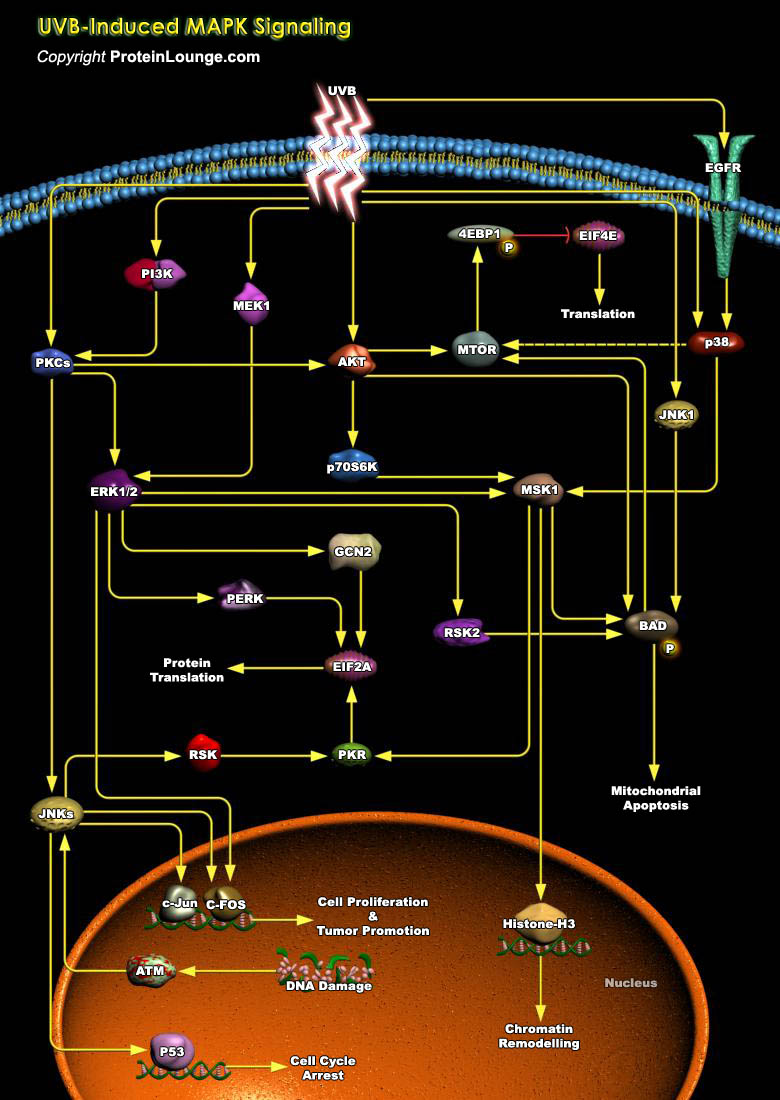
Ultraviolet radiation (UVR) is an electromagnetic radiation that is shorter in wavelength than visible light but longer than X-rays. It falls in the range of 100nm to 400nm and is the most important environmental carcinogen leading to the development of skin cancers. UVR is divided into at least three different categories based on wavelength that includes ultraviolet C (UVC; 100–280 nm), ultraviolet B (UVB; 280–320 nm) and ultraviolet A (UVA; 320–400nm). UVB can be directly absorbed by DNA molecules and thus causes UV-signature DNA damages. UVB promotes tumor growth through various signaling pathways. (Ref.1). UVB unlike UVA, comprises only a small amount of the UVR from the sun at the surface of the Earth and it affects cells within the[..]
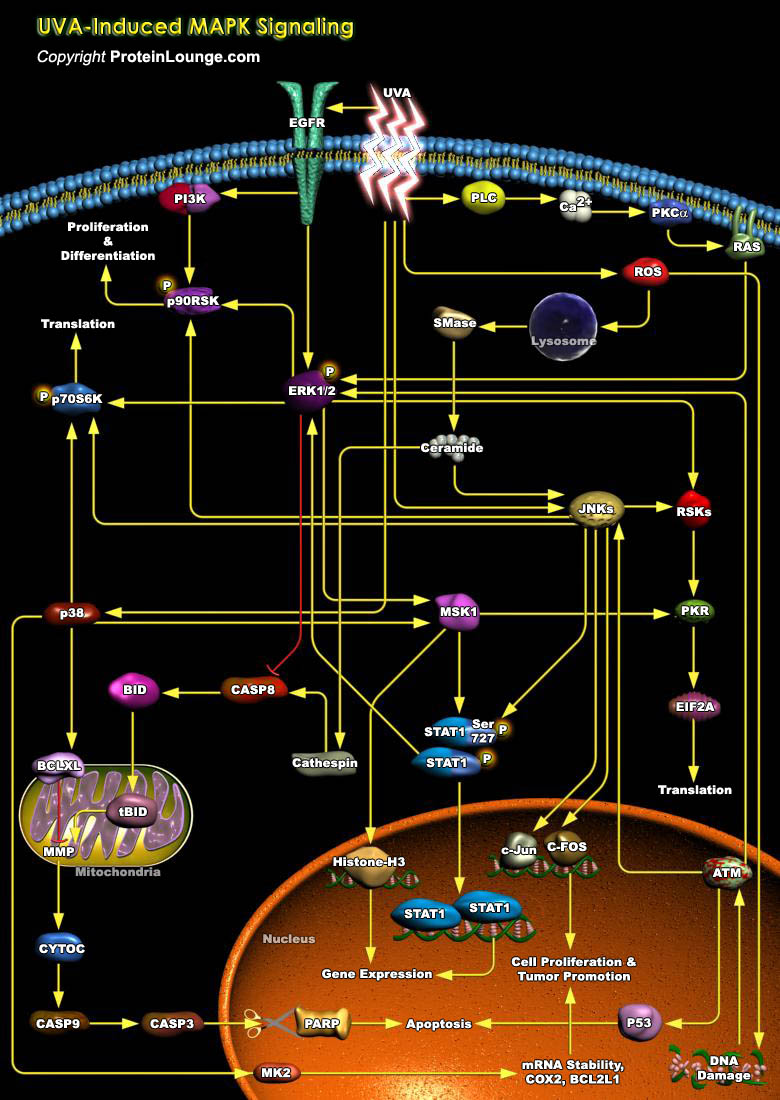
Ultraviolet radiation (UVR) is an electromagnetic radiation that is shorter in wavelength than visible light but longer than X-rays. It falls in the range of 100nm to 400nm and is the most important environmental carcinogen leading to the development of skin cancers. UVR is divided into at least three different categories based on wavelength that includes ultraviolet C (UVC; 100–280 nm), ultraviolet B (UVB; 280–320 nm) and ultraviolet A (UVA; 320–400nm). 90-95% of terrestrial radiation from the midday sun comprises UVA that can reach the dermal layer of human skin (Ref.1). UVA can cause DNA damage by producing reactive oxygen species (ROS) and can induce skin cancer. UVA irradiation affects cellular signaling mechanisms and is known to[..]
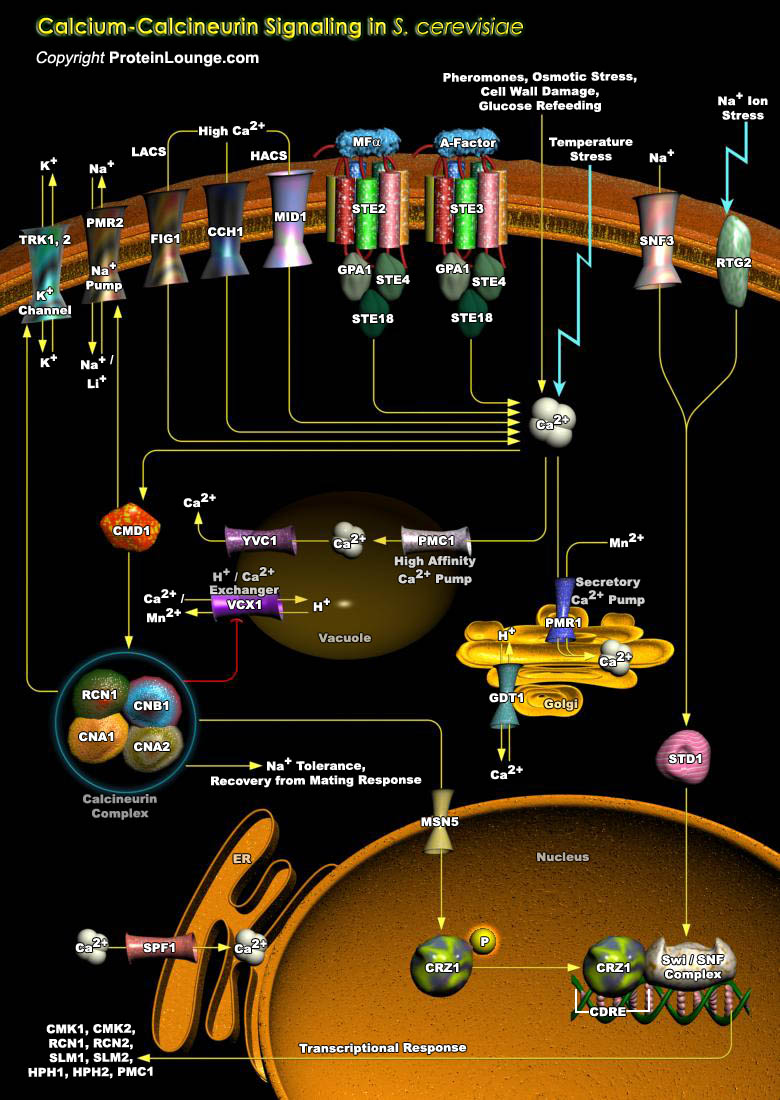
In the yeast S. cerevisiae (Saccharomyces cerevisiae) various stimuli and developmental cues excite calcium (Ca2+) signals, which initiate appropriate downstream responses by changing the conformation of Ca2+ binding proteins. This is usually characterized by a sharp rise in cytosolic free Ca2+ followed by an exponential decrease. The cytosolic calcium homeostasis is maintained and regulated by Ca2+ transporters and sequestrators in the plasma and organelle membranes. Calcium can be either stored in the vacuoles or in secretory compartments of ER and Golgi where the vacuole acts as the main organelle for storage and sink, and the compartmentalization of Ca2+ in the ER/Golgi revealed a pathway for depleting and recycling intracellular calcium (Ref.1).Upon elevation of[..]
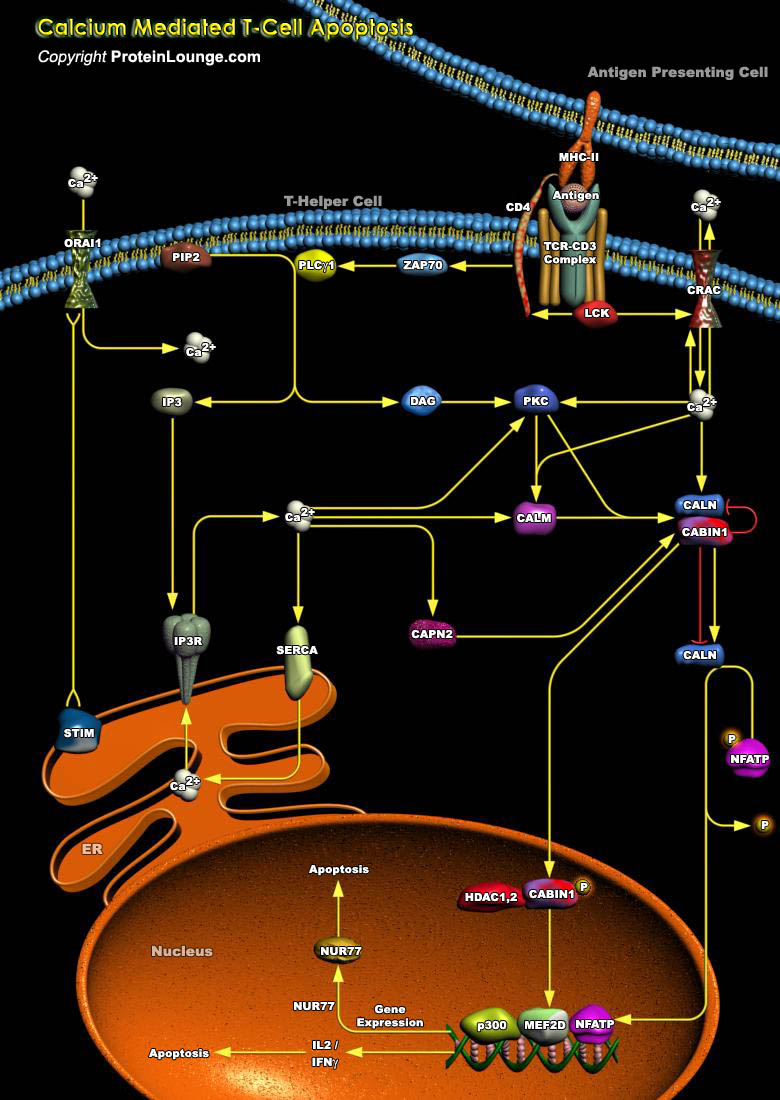
Ca2+ (Calcium) plays a major role in life and death within T-Cells. Elevation of intracellular free Ca2+ is one of the key triggering signals for T-Cell activation by antigen. The binding of antigen, MHC Class-II (Major Histocompatibility Complex Class-II), to the TCR-CD3 (T-Cell Antigen Receptor)-CD3 (CD3 Antigen) triggers the recruitment of a series of tyrosine kinases and substrates to the TCR/CD3/CD4 (CD4 Antigen) Complex, ultimately resulting in the phosphorylation and activation of PLC-Gamma1 (Phospholipase-C-Gamma1). PLC-Gamma1 cleaves PIP2 (Phosphatidylinositol 4,5-bisphosphate) in the plasma membrane to generate DAG (Diacylglycerol), which activates PKC (Protein Kinase-C) and IP3 (Inositol 1,4,5-trisphosphate), that causes entry of Ca2+ to cytosol from two[..]
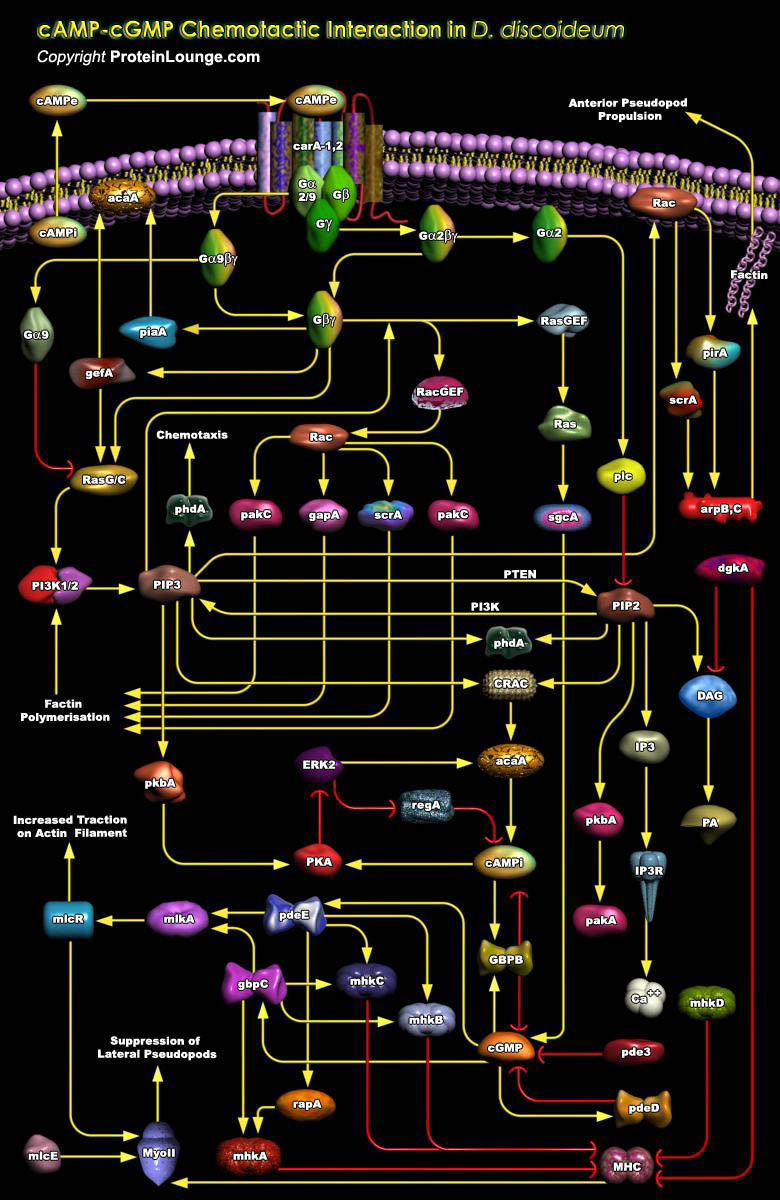
Commonly referred to as slime mold, Dictyostelium discoideum is a species of soil-dwelling amoeba belonging to the phylum Amoebozoa, It is a eukaryote that transitions from a collection of unicellular amoebae into a multicellular slug and then into a fruiting body within its lifetime. Bacteria are attracted to nutrients and repelled from toxic chemicals for their survival. Amoeba exibit movement in response to a chemical stimulus commonly termed as Chemotaxis. D. discoideum secretes the signal in form of cAMP, out of the cell, attracting other amoebae to migrate toward the source. i.e the amoeba dispensing the greatest amount of cAMP secretions. The secretion of the cAMP is then exhibited by all amoebae and is a call for them to begin aggregation. Chemotaxis is a[..]
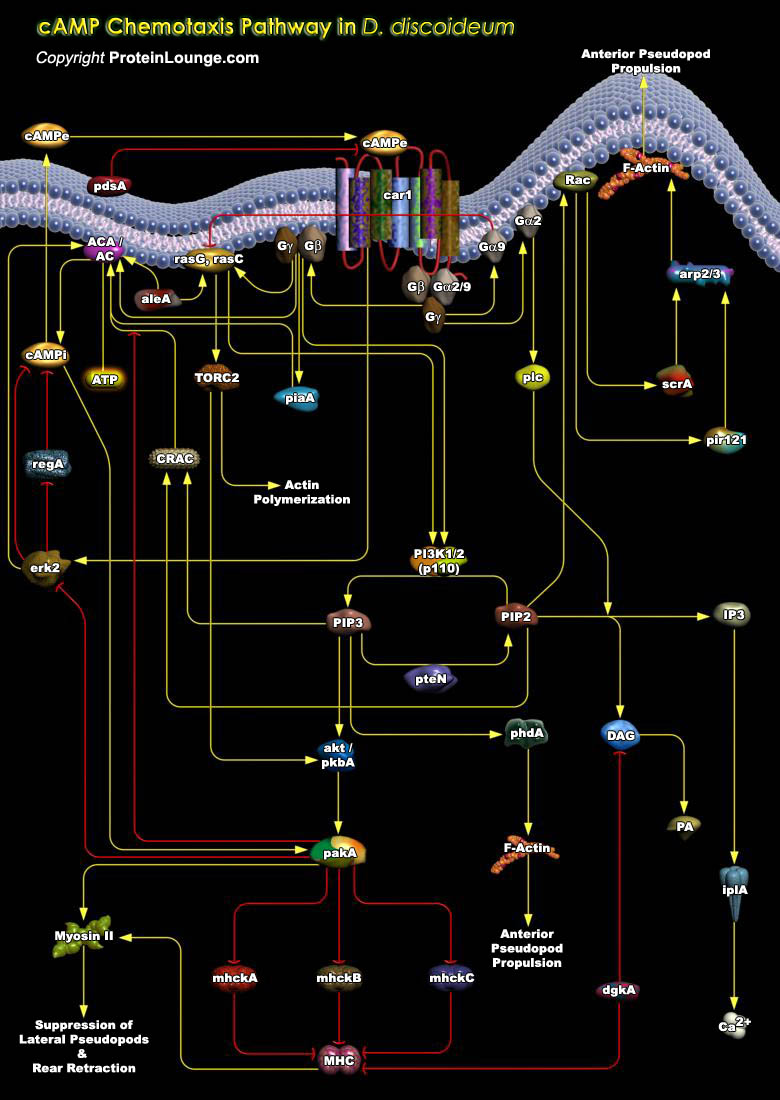
Dictyostelia are a group of organisms that generally aggregate to become multicellular. There are approximately 120 known species of Dictyostelium. Dictyostelium discoideum belonging to the group 4, secrete cyclic adenosine monophosphate (cAMP) toact as a chemo attractant for aggregation. Dictyostelium is a simple eukaryotic model for the study of chemotaxis. Advantages of D. discoideum as a model organism include its genetic, biochemical and cell biological accessibility (Ref.1). The social amoebae D. discoideum has proven indispensable to elucidate signaling events that regulate Chemotaxis. In D. discoideum, cAMP (Cyclic Adenosine 3'-5'-Monophosphate), Folic Acid as well as factors from Bacteria, serve as Chemoattractants. In Dictyostelium, chemotaxis is[..]
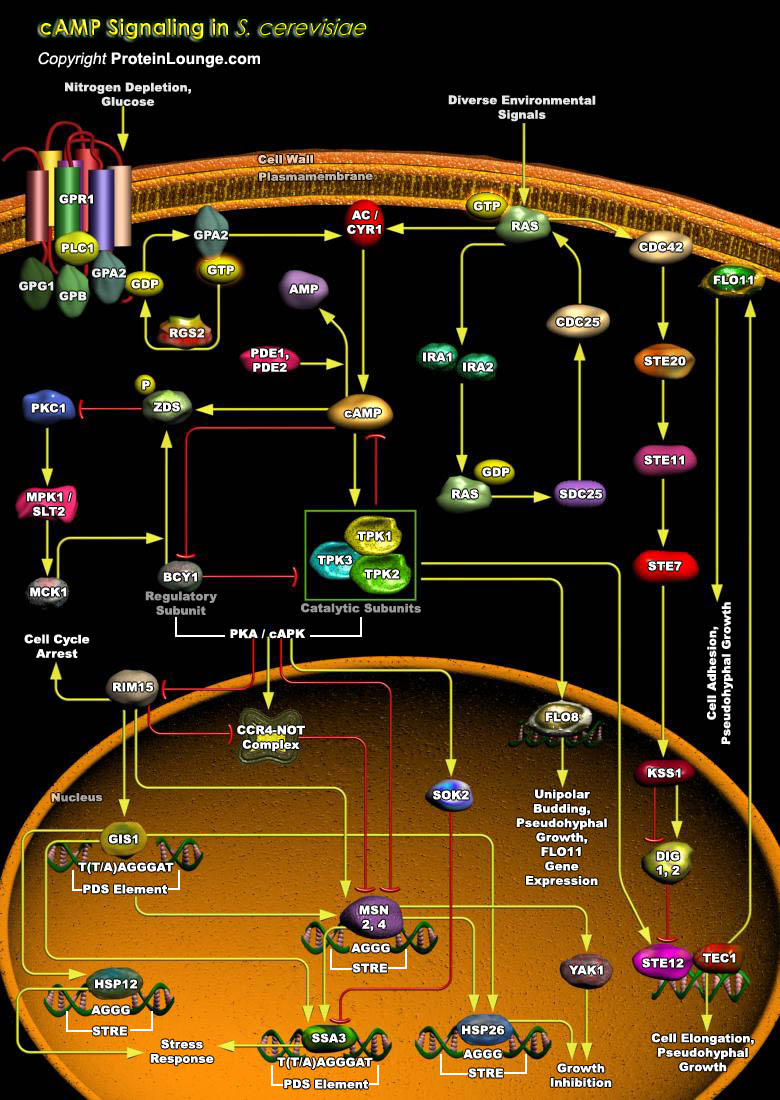
Nutrient derived signals are generally sensed by all organisms in order to adapt themselves to the environment and promote survival. In the budding yeast Saccharomyces cerevisiae (S.cerevisiae), extracellular glucose and a plethora of signals regulate the production of intracellular cAMP. cAMP and associated pathway is important in growth regulation, cell metabolism, virulence, morphogenesis and stress resistance (Ref.1 and 2). cAMP, the central messenger of the pathway is synthesized from ATP by the action of adenylae cyclase encoded by the CYR1/CDC35 gene and the cyclase-associated protein (CAP) encoded by the SRV2 gene (Ref.3).G-protein receptor GPR1 and associated G-alpha subunit GPA2 regulate the activity of adenylate cyclase and cAMP. A small G protein RAS also[..]
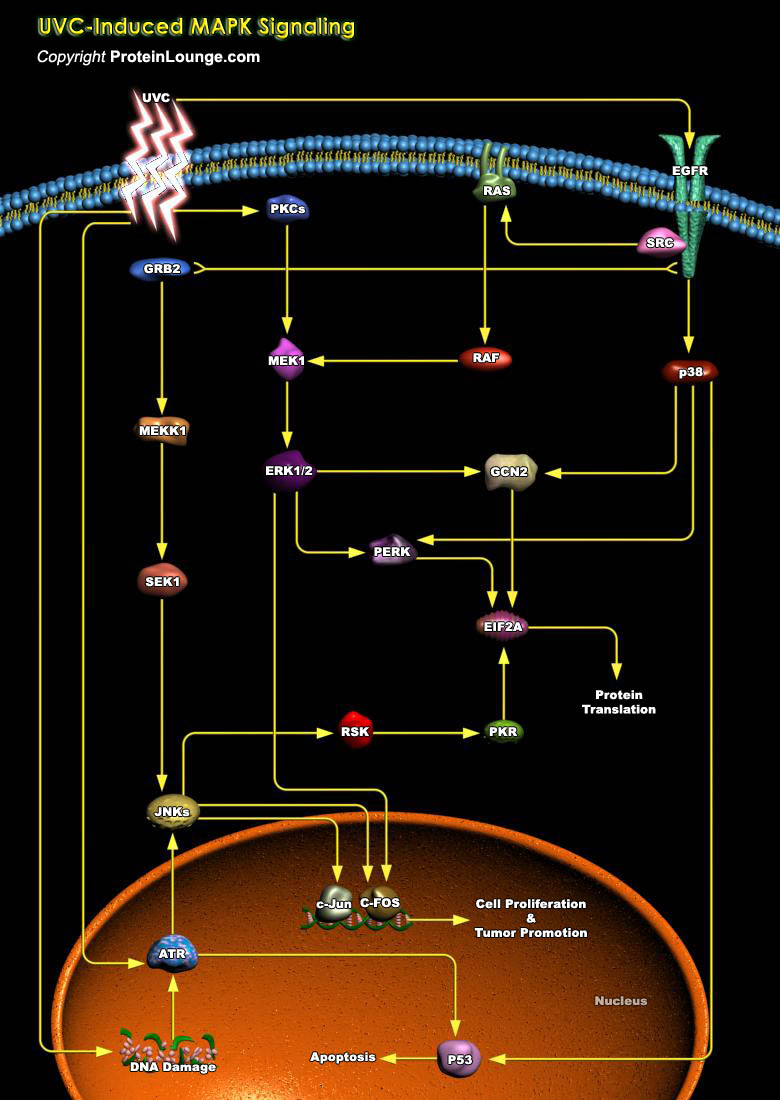
Ultraviolet radiation (UVR) is an electromagnetic radiation that is shorter in wavelength than visible light but longer than X-rays. It falls in the range of 100nm to 400nm and is the most important environmental carcinogen leading to the development of skin cancers. UVR is divided into at least three different categories based on wavelength that includes ultraviolet C (UVC; 100–280 nm), ultraviolet B (UVB; 280–320 nm) and ultraviolet A (UVA; 320–400nm). The energy level of UV light is inversely related to its wavelength with UVC possessing higher levels than that of UVB (Ref.1). The MAPK (Mitogen-Activated Protein Kinase) signaling cascades are targets for UV and are important in the regulation of the multitude of UV-induced cellular[..]
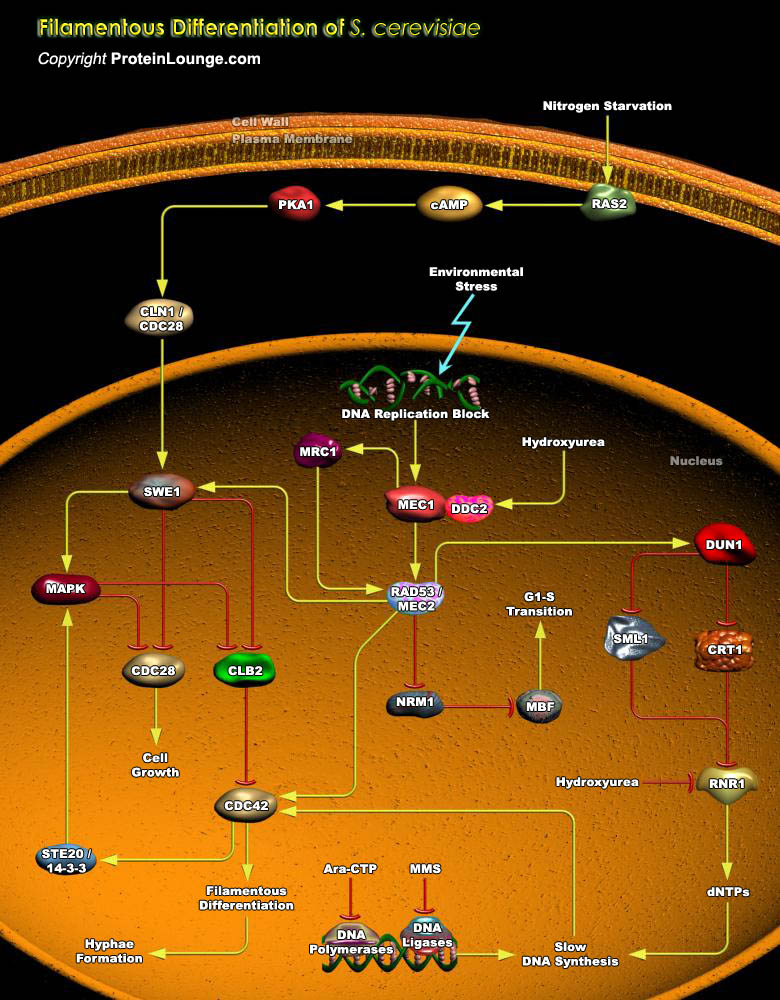
Unicellular S.cerevisiae (Saccharomyces cerevisiae) undergoes developmental switches between two differentiation states in response to environmental cues. Under stress conditions, diploid S.cerevisiae cells switch from the yeast form (growth as single oval cells) to the filamentous or pseudohyphae form (growth as elongated cell chains that retain physical attachment between the mother and daughter cells). Filamentous differentiation of S.cerevisiae is a potential model system for study of eukaryotic differentiation. Slowed DNA synthesis induces filamentous differentiation in yeast and it involves the conserved cell cycle regulators Swe1 (Mitosis Inhibitor Protein Kinase-Swe1), CLB2 and CDC28 (Cell Division Control Protein-28) (Ref.1). DNA integrity checkpoints are[..]
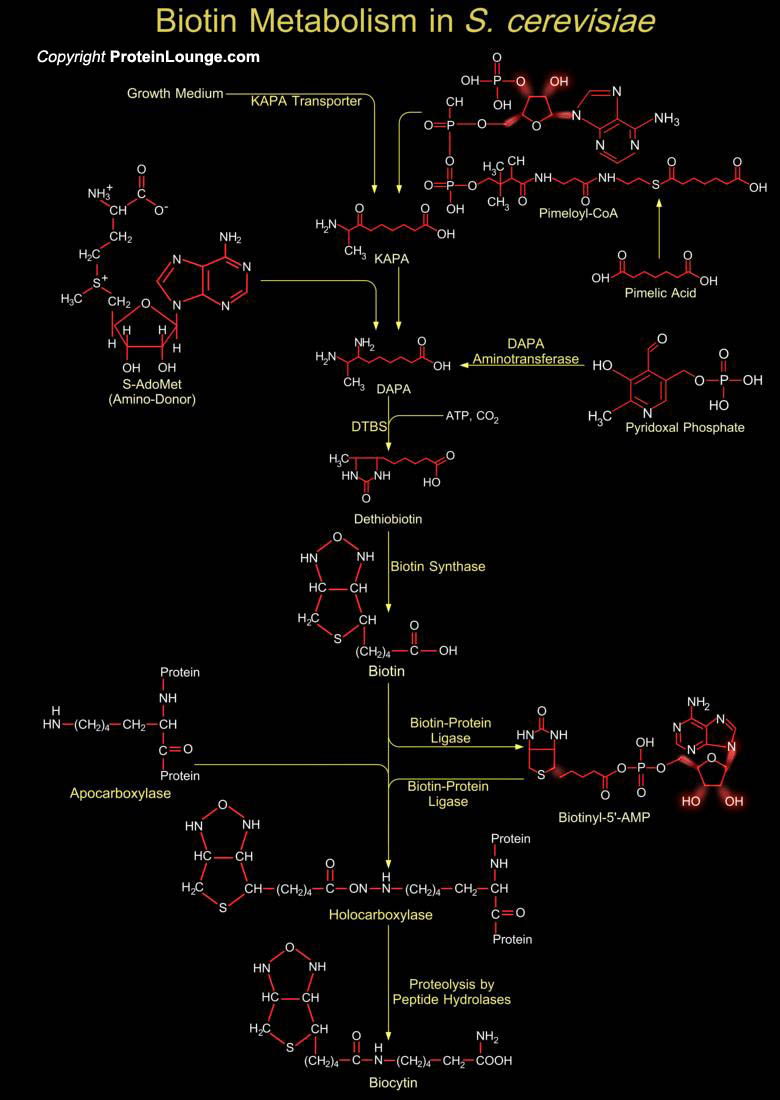
In unicellular eukaryotes like S. cerevisiae (Saccharomyces cerevisiae), Biotin or Vitamin-H, a member of B-Complex group of Vitamins acts as a cofactor for a few essential enzymes of the Carboxylase family. It is also required for the biosynthesis of fatty acids and the metabolism of amino acids and carbohydrates. Some organisms, including higher plants and most fungi and bacteria, are prototrophic for Biotin. Others, including most vertebrates and some bacteria, rely on exogenous sources (Ref.1 & 2). In mammals, Biotin is supplied by intestinal bacteria. Biotin is a colorless Vitamin and Orthorhombic when crystallized. It consists of two fused rings: an Imidazol (Ureido) and a Sulfur-containing (Tetrahydrothiophene) ring; and the latter is extended via[..]
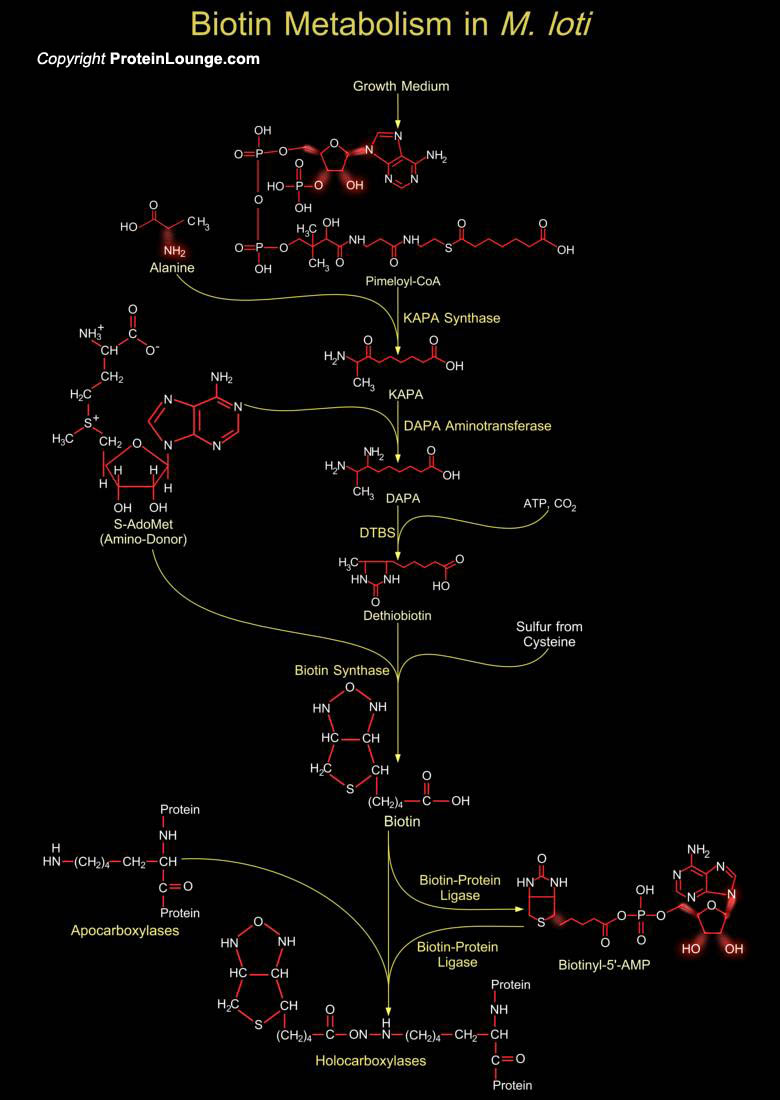
Symbiotic bacteria, together with Phytopathogenic microbes, are plant-interacting microorganisms of major agronomic importance. Among these, Rhizobia are root-nodule-forming Nitrogen-Fixing Legume Symbionts. These microorganisms, in addition to providing an ideal model for studying plant-microbe interactions, play an important role in global nutrient cycling. In Rhizobium sp. also known as Mesorhizobium sp., the majority of the symbiosis genes are contained on a 500 kb (500 Kilobase) chromosomal genetic element termed a Symbiosis Island (Strain R7A). Phenotypic characterization of the Non-Symbionts present in the environment, reveals that they are initially auxotrophic for Biotin (or Vitamin-H) and Thiamin (Vitamin-B1) (Ref.1). Transfer of the Symbiosis Island from[..]

